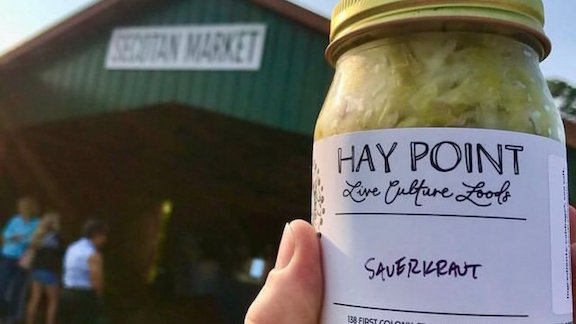
Fermentation Basics: Sauerkraut
Originally presented June 27, 2020 at Island Farm in Manteo
What is Lacto-Fermentation?
Lacto-fermentation is the natural process where beneficial bacteria break down plant sugars into lactic acid, which acts as a natural preservative. These lactic acid bacteria (LAB) exist naturally on the surface of vegetables, introduced through contact with soil, water, and air. Fresh vegetables host not only these beneficial bacteria but also potential spoilage organisms like fungi, yeasts, and other undesirable bacteria that eventually lead to decay unless the vegetables are consumed or preserved.
Vegetable fermentation has served as a preservation method for thousands of years across diverse cultures. The common thread connecting all vegetable fermentation traditions is the addition of salt. Salt draws moisture from vegetables, creating a brine that keeps them submerged—crucial for a successful ferment. This salty environment encourages beneficial lactic acid bacteria to thrive while inhibiting organisms that cause spoilage. Finding the right salt balance is essential for both food safety and achieving the distinctive flavor of properly fermented vegetables.
Beyond preservation, lacto-fermentation enhances the nutritional profile of vegetables by making nutrients more bioavailable and introducing probiotic organisms that support a healthy gut microbiome.
What is Sauerkraut?
Sauerkraut, meaning "sour cabbage," is often associated with German cuisine, though the first documented cabbage fermentation originated in China. While countless variations exist, traditional sauerkraut consists simply of cabbage and salt. At Hay Point, our house recipe includes a touch of caraway seed, perhaps the most common traditional flavoring. Properly prepared sauerkraut typically requires 7-14 days to ferment to perfection.
Sauerkraut Recipe
Makes approximately one half gallon
Ingredients:
- 3.25 pounds cabbage
- 1-1.5 tablespoons (0.8 ounces) sea salt
- Optional: 1/8 teaspoon caraway seed, beets, carrots
Instructions:
- Peel, wash, and core the cabbage. If using beets and carrots, peel and wash them as well.
- Set aside one large cabbage leaf for later use. Chop or shred the remaining vegetables to your preferred size and texture.
- Mix in about two-thirds of your salt, squeezing and massaging thoroughly to force the salt in and draw water out.
- Add caraway seed (if using) and mix well.
- Taste a small bite—the salt should be noticeable but not overwhelming. Add the remaining salt if desired and mix thoroughly.
- Pack the mixture into a jar, pressing firmly to remove air pockets.
- Place the reserved large cabbage leaf on top of the shredded vegetables, then add a glass weight, pressing down to submerge all vegetable matter in brine. (Remember: SUBMERGE IN BRINE AND ALL WILL BE FINE!)
- Secure the lid on the jar, but not too tightly to allow gases to escape.
- Place the jar in a bowl or dish on the counter where you can monitor it, away from direct sunlight.
- Once a day, use a clean spoon or hands to push down on the weight, forcing gases out and ensuring the vegetables remain submerged in brine.
- As early as day four or five, sample a small taste to check if the acidity meets your preference. At around 70°F, sauerkraut typically reaches optimal flavor around day ten, but variables exist, and you can begin enjoying your kraut whenever it tastes good to you.
- When finished, remove the cabbage leaf and weight, then pack the kraut into smaller jars. Press down firmly to eliminate air pockets and top off with remaining brine if necessary.
- Properly stored, sauerkraut will keep refrigerated for 12 months or longer.
Have questions about your fermentation process? Feel free to contact Owen at haypointfermentation@gmail.com or (252) 305-4504.
Happy Fermenting!
